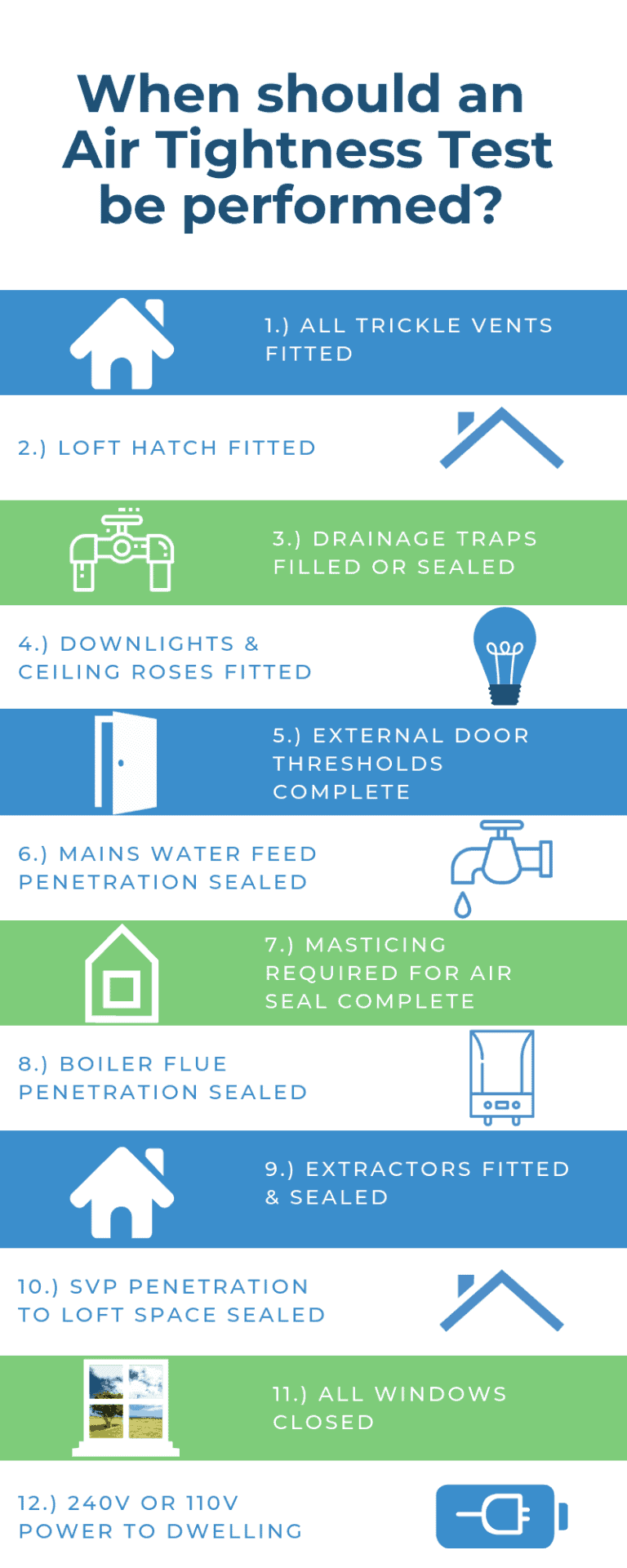
Part E Building Regulations
There are several things to consider when soundproofing. One of which is complying with the Part E building regulations. This blog will talk through these

Many of us have heard of Air Tightness Testing, or maybe you have been told that you need an Air Permeability test. But what exactly is it? When do you need it? And what is the Air Tightness test procedure? Here we will outline the basic understanding you should have before you begin your research into Air Tightness testing companies.
Air Tightness Testing is a recognised method of measuring the extent to which uncontrolled flow of air is lost through the gaps and cracks in the fabric of a building. It is also called Air Testing/ Air Pressure Testing/Air Leakage Testing.
Air Testing falls under Part L of the Building Regulations and the Scottish Building Standards. England and Wales have had separate building regulations since 2011. However as far as carrying out an airtightness test, there’s no difference. Reducing air leakage results in reduced heating energy use and lower CO2 emissions. It therefore decreases the heating costs associated with the building and improves the occupant comfort. As the government strives to reduce CO2 emissions from new buildings, greater emphasis is on the quality of the fabric of a new building.
Building Regulations require that all new buildings carry out energy calculations. There are specific air pressure regulations that all new dwellings need to conduct in compliance with Part L of the Building Regulations, therefore in accordance with ATTMA Technical Standard (ATTMA TSL1). Buildings other than non-dwellings also need it in accordance with ATTMA Technical Standard L2 (ATTMA TSL2). Furthermore, air tightness testing plays an integral role in ensuring that the energy calculation Building Carbon Dioxide Emission Rate (BER) is less than the Target Emission Rate (TER).
So whether you’re a small developer or a large housing contractor, you will need to perform an Air Permeability test on your new builds before completion. An air tightness test is usually completed towards the end of the construction process and then the results are used to determine your overall energy rating, (SAP for dwellings and SBEM for commercial buildings). You need to complete an air tightness test to ensure that your building is compliant with building emission rates.
Your building’s emission rates must be lower than the target emissions rate to comply with all building regulations. This is because the government is constantly making steps to reduce overall emissions, hence the rates and targets now implemented on dwellings and commercial buildings. It’s estimated that construction makes up approximately 50% of all emissions, so it’s very important to aim for a good air tightness test result. A high level of air tightness can improve your emissions rate and keep heat from escaping through small cracks in the building work. However, we also don’t want the building to be too tight because this can cause mould and condensation.
Before you request an Air Leakage test, ensure that you have met certain requirements. Ensure that the properties are in fact, up to a standard of readiness. This includes:
If you have completed the above lists and are confident that everything is up to a high quality standard, you are now ready to perform an Air Tightness Test.

Before the test takes place, you will need an initial assessment (usually free) to establish your air testing regulations and requirements.
On the day the process is very straightforward and our experienced engineers will get to work right away. Although hard to understand, the basics of the process you need to know are as follows:
This test procedure would normally take no longer than an hour to perform after setup and once complete. Once we are finished you will be issued with an on-site draft certificate. In short, we measure the ratio of volume of air passing through our fan to the pressure difference between the outside and inside of the building. This determines the Air Permeability Index in the form of something that looks like this m3h-1m-2 (air permeability rate per hour, per square meter of envelope area). In the UK the Maximum Air Permeability is 10 m3h-1m-2.
Air Tightness Testing is a necessity for all new build developers and requires consideration at all stages of the build process with the final test being undertaken at completion stage. If you are in need of an Air Permeability test or would like to understand more about the process, please give us a call and we’ll be happy to discuss your specific requirements.

There are several things to consider when soundproofing. One of which is complying with the Part E building regulations. This blog will talk through these

Soundproofing testing can be a perplexing subject on which to get all the required information, especially if you are a beginner. From the terminology to

Noise rating curves are an agreed set of curves relating octave-band sound pressure level to the centre frequency of the octave bands, each of which

It is becoming an increasing necessity to those operating large scale businesses, but what actually is a commercial energy audit? One of the most significant

The achievement of the UK target for net zero by 2050 is highly challenging and will require a coordinated effort by us all living

When you need to reduce noise transmissions, whether it’s for personal reasons or professional obligations, the first thing on your mind will likely be ‘how



There are several things to consider when soundproofing. One of which is complying with the

Soundproofing testing can be a perplexing subject on which to get all the required information,